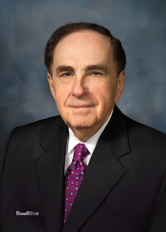“We are creating a culture of excellence at UNMC that is infectious.”
James B. Milliken, president, University of Nebraska
 Since becoming chancellor seven and a half years ago, Harold M. Maurer, M.D., has been committed to building UNMC’s future.
Since becoming chancellor seven and a half years ago, Harold M. Maurer, M.D., has been committed to building UNMC’s future.
At Tuesday’s Annual Faculty Meeting at the Durham Research Center Auditorium, Dr. Maurer delivered a stirring state-of-the-campus address in which he spelled out his vision for the future, while outlining the accomplishments of the past year and detailing the challenges that lie ahead.
The 35-minute speech, titled “Building UNMC’s Future,” provided those in attendance with optimism that UNMC is truly on the path to becoming a world-class academic health science center.
Three members of the University of Nebraska Board of Regents – Randy Ferlic, M.D., James McClurg, Ph.D., and Dan Connealy, UNMC’s student regent – were among those who heard the message. Dr. Ferlic praised the medical center in his brief opening remarks, as he said, “This institution has made tremendous progress.”
Dr. Maurer emphasized the importance for institutions to have vision. “We have a target, a vision,” he said. “If your vision is fuzzy, you’ll never attain it. Our vision is consistent.”
Under Dr. Maurer, the UNMC vision has continued to focus on providing the best possible patient care, education and research, while embracing community outreach and diversity. Now, a sixth element – creating economic growth in Nebraska – has been added to UNMC’s vision statement.
Two of the key ways UNMC is moving forward, Dr. Maurer said, is through its culture of discipline and its positive work environment. “We have a thousand points of yes,” he said.
The presentation, which featured computer-generated photos of the chancellor and other UNMC leaders in yellow construction helmets, tool belts and work clothes, highlighted the building growth taking place at UNMC.
Dr. Maurer listed 15 construction projects that are currently in progress or recently completed. The three biggest projects currently in the works are the Michael F. Sorrell Center for Health Science Education at 42nd and Emile streets, the Research Center of Excellence II at Durham Research Plaza and Emile Street, and the current Good Manufacturing Practices (cGMP) Transplant Production Facility near 42nd and Emile streets. All three of these projects should be completed within the next two years.
In addition, several older buildings on the UNMC campus – Poynter Hall, Bennett Hall, Wittson Hall and the Eppley Cancer Institute – will be renovated, along with the College of Dentistry in Lincoln, thanks to the Nebraska State Legislature passing LB 605 this year, providing the entire University of Nebraska system and state colleges with $155 million over the next 14 years to maintain and make renovations on older buildings.
Dr. Maurer saluted UNMC’s hospital partner, The Nebraska Medical Center, and said the nearly nine-year merger has been “very successful.” He cited two major building projects involving the hospital – the completion last year of the Hixson-Lied Clinical Center of Excellence and the anticipated construction of a new medical center in Bellevue. The Nebraska Medical Center and UNMC Physicians, the UNMC physician group practice, also are moving forward on building a new medical center in the West Village Pointe development just south of 180th and Dodge streets.
One key reason UNMC has been able to undertake so many different construction projects, Dr. Maurer said, is because of the many philanthropic gifts made to UNMC by community leaders, foundations and others. “The community likes to support winners,” he said, “and they see the medical center as a winner.”
In his review of the past year, Dr. Maurer cited more than 25 accomplishments that made headlines in the past year. These included opening the largest biocontainment unit in the country in University Tower, launching a statewide lung cancer screening program, developing a gene chip to assist AIDS vaccine development, and authoring the first textbook on health care disparities.
Dr. Maurer listed a variety of challenges that must be addressed. These included manpower shortages, skyrocketing health care costs, cuts in nation research funding, campus space constraints, and the ongoing culture evolution between UNMC and The Nebraska Medical Center.
He wound up his presentation by paraphrasing a statement made by Jim Collins, a leading U.S. business consultant.
Dr. Maurer said the statement provides a perfect summary of what the future holds for UNMC. It read: “Every academic medical center has a unique set of irrational and difficult constraints, yet some make a leap, while others do not. Excellence is not a function of circumstance, but largely a matter of conscious choice and discipline.”